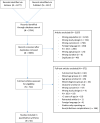Incisional hernia after surgical correction of abdominal congenital anomalies in infants: a systematic review with meta-analysis
- PMID: 33273483
- PMCID: PMC7713071
- DOI: 10.1038/s41598-020-77976-1
Incisional hernia after surgical correction of abdominal congenital anomalies in infants: a systematic review with meta-analysis
Abstract
Incisional hernia (IH) in children could result in life-threatening complications, including incarceration and bowel strangulation. The incidence and risk factors of IH in infants are scarcely reported. Since IH-correction may require extensive surgery and a long recovery program, identifying infants and birth defects at risk, may lead to a different approach during the primary surgery. Therefore, the aim of this review is to systematically review the available data on the incidence of IH following surgery for congenital anomalies in infants. All studies describing IH were considered eligible. PubMed and Embase were searched and risk of bias was assessed. Primary outcome was the incidence of IH, secondary outcomes were difference in IH occurrence between disease severity (complex vs simple) and closure method (SILO vs primary closure) in gastroschisis patients. A meta-analysis was performed to pool the reported incidences in total and per congenital anomaly separately. Subgroup analysis within gastroschisis articles was performed. The 50 included studies represent 3140 patients. The pooled proportion of IH was 0.03 (95% CI 0.02-0.05; I2 = 79%, p ≤ 0.01) all anomalies combined. Gastroschisis (GS) reported highest pooled proportion 0.10 (95% CI 0.06-0.17; n = 142/1273; I2 = 86%; p ≤ 0.01). SILO closure (OR 3.09) and simple gastroschisis, i.e. without additional anomalies, (OR 0.18) were of significant influence. This review reports the incidence of IH in infants with different congenital abdominal anomalies, of which gastroschisis reported the highest risk. In GS patients, complex GS and SILO closure are risk factors for IH development.
Conflict of interest statement
The authors declare no competing interests.
Figures
References
-
- McCann ME, et al. Neurodevelopmental outcome at 5 years of age after general anaesthesia or awake-regional anaesthesia in infancy (GAS): an international, multicentre, randomised, controlled equivalence trial. Lancet (Lond., Engl.) 2019;393:664–677. doi: 10.1016/s0140-6736(18)32485-1. - DOI - PMC - PubMed
Publication types
MeSH terms
LinkOut - more resources
Full Text Sources
Medical





